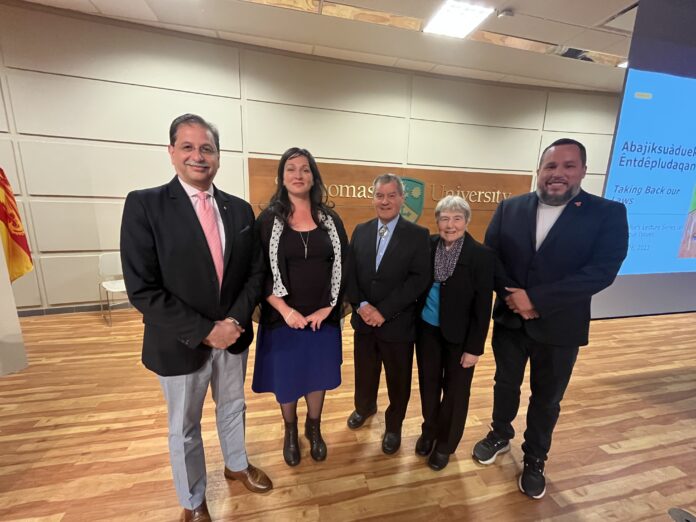

On Oct. 26, Naiomi Metallic delivered the Chancellor’s Lecture on Indigenous issues at St. Thomas University’s Kinsella Auditorium.
After working at a law firm with Mìgmaq clients in New Brunswick and Nova Scotia, Metallic received her masters and began teaching law courses at the University of Dalhousie Faculty of Law.
At Dalhousie, she challenged herself to learn her own language and develop an Indigenous law course. “I said ’in three years, you will teach in Indigenous law, you will know what this is all about and to do that, you will learn your language.’”
Metallic clarified the significant difference between Aboriginal and Indigenous law.
“Aboriginal law is Canadian law as it relates to Indigenous people. That can include section 35 of the Constitution. It includes the Indian Act,” she said.
Indigenous law, by contrast, is law rooted in Indigenous societies and communities across Canada.
The Truth and Reconciliation Committee (TRC) has pointed to a legal framework from the UN Declaration of Rights for Indigenous Peoples that needs to be included in reconciliation in Canada.
The TRC said that Aboriginal people must be able to recover, learn and practice their own distinct legal traditions. Establishing respectful relations requires the revitalization of Indigenous laws.
Metallic also pointed to the TRC’s article three, which speaks to the right to self-determination.
“The right to self-determination of Indigenous peoples includes the right to autonomy or self-government in matters relating to their internal and local affairs.”
Indigenous law offers a different perspective compared to traditional Canadian law. Metallic believes Indigenous law looks beyond the top-down structure Canadian law follows.
“Think about law as what all societies and cultures have when groups of people live together. They have disputes, they have agreements, they have all kinds of interactions … A law is really a base of our concepts of justice, fairness, peace and relationships.”
Metallic noted the over-representation of Indigenous children in welfare systems and how the criminal justice system has failed Indigenous people. She said that Indigenous law can be the alternative required to resolve these issues.
Metallic said there are “interesting things happening” in law schools and courts across the country who use Indigenous law principles in their decisions and learning.
“There are some interesting things that are happening here … There’s some amazing work happening in different law schools in Canada and there are scholars who are coming up with ways to work with communities to revitalize their laws.”
Metallic finds her new work rewarding and thinks storytelling is an integral part of the revitalization of Indigenous law.
“When I do this work with community, and I see them saying, ‘Oh my God, there’s so much richness in our stories, language and our other sources of law.’”
